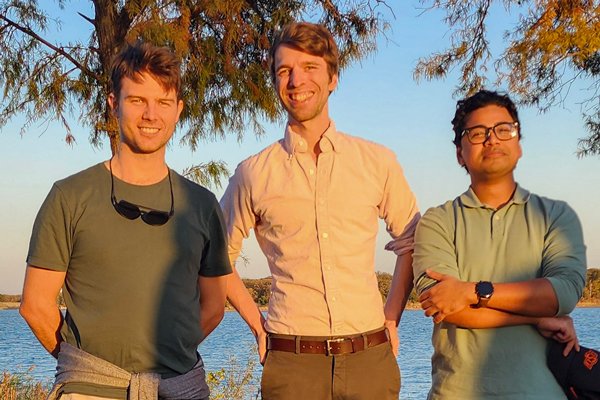
OSU physicists discover universal ‘Squeezing Phase Transition’ with implications for quantum technology
Wednesday, October 15, 2025
Media Contact: Elizabeth Gosney | CAS Marketing and Communications Manager | 405-744-7497 | egosney@okstate.edu
Findings establish new dynamical phases of matter, advancing quantum sensing and simulation
A team of physicists at Oklahoma State University led by assistant professor Dr. Thomas Bilitewski has identified universal behavior in the way quantum systems evolve, with potential applications in quantum enhanced sensors.
The findings, which advance our understanding of entanglement or the quantum property famously described by Albert Einstein as “spooky action at a distance,” were published in the journal Physical Review Letters on Sept. 11.
Bilitewski’s research team includes graduate student Arman Duha and postdoctoral researcher Dr. Samuel Begg. The trio studied the dynamics of quantum spins with long-range interactions and how they generate entanglement, a uniquely quantum resource critical for quantum-enhanced next-generation technology.
The team found that the quantum system shifts between two distinct dynamical phases: In the “fully collective” phase, all spins synchronize, similar to how fireflies in a swarm synchronize their flashes. In that state, the system achieves ultimate precision, allowing what is known as “Heisenberg-limited” sensing, a theoretical maximum for quantum-enhanced sensing.
“Interestingly, there is another ‘partially collective’ phase, in which the system still allows quantum enhanced sensing, but the spins do not behave fully collectively,” Bilitewski said. “It was found that the evolution of the system in that phase follows universal laws, similar to those that govern systems close to phase transitions more familiar to us, like ice melting into water or water evaporating into vapor.”
This regime illustrates a persistence of quantum information against strong local interactions between neighboring spins that would typically drive such a complex, many-body system towards chaos.
“Our work shows that the way these quantum systems evolve and how entanglement is generated isn’t random; it’s governed by universal laws,” Bilitewski said. “This fundamentally improves our understanding of how to generate entanglement with the goal to design quantum systems that offer a real advantage over classical systems.”
The findings could directly impact a wide range of real-world technologies. Quantum sensing, which uses quantum resources in the form of entanglement to achieve unprecedented measurement precision, has potential applications ranging from navigation to fundamental science over medical imaging. Additionally, the generation and control of entanglement and entangled states, as fundamental resources of quantum information, are also critical for quantum computation.
“Dr. Bilitewski and his team’s work is a fantastic example of the groundbreaking research being done in the Department of Physics at Oklahoma State University,” said Dr. Flera Rizatdinova, OSU physics department head. “By deepening our fundamental understanding of the quantum world, their work is laying the foundation for future advancements and solidifying our university’s leadership in this transformative field.”
The research, titled “Nonequilibrium Critical Scaling of a Squeezing Phase Transition,” was published in the Sept. 11, 2025, issue of Physical Review Letters and can be accessed here.
